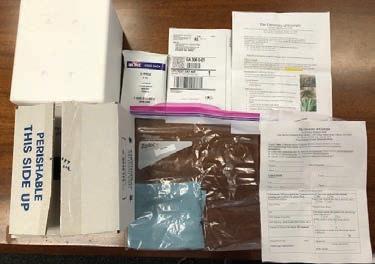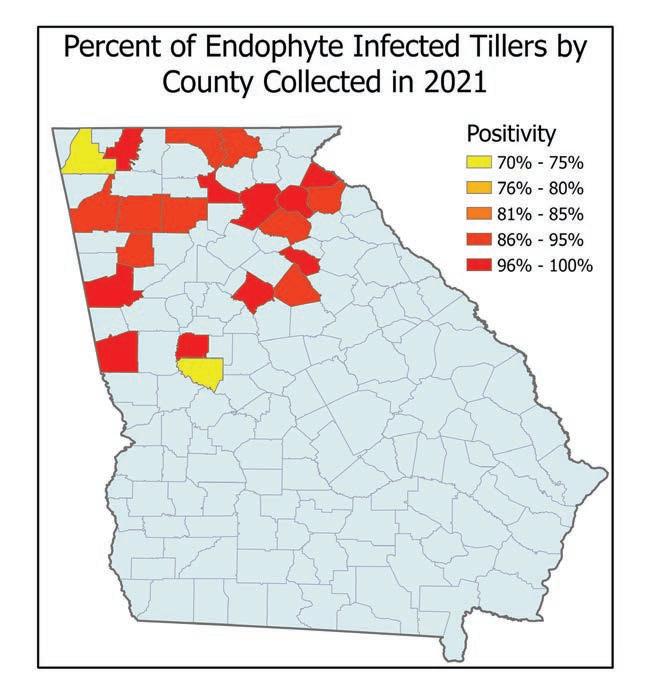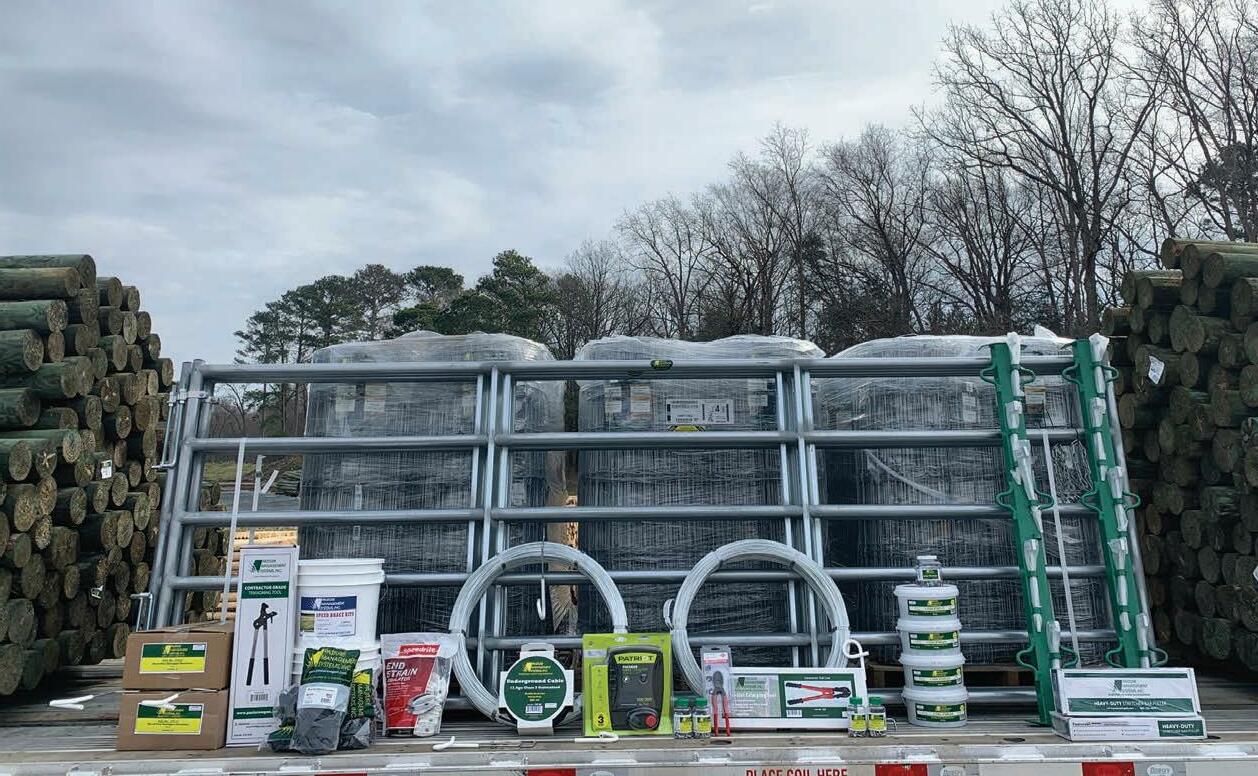
7 minute read
Toxic Endophyte Infection in Georgia Fescue Pastures is Severe and Widespread By Dr. Uttam Saha, Senior Public Service Associate and Program Coordinator, Ag and Environmental Services Labs, UGA, et al.
Toxic Endophyte Infection in Georgia Fescue Pastures is Severe and Widespread
By Dr. Uttam Saha: Senior Public Service Associate and Program Coordinator, Agricultural and Environmental Services Laboratories, UGA Dr. Lisa Baxter: Assistant Professor and State Forage Extension Specialist, Department of Crop and Soil Sciences, UGA Dr. Lawton Stewart: Professor and Extension Coordinator, Department of Animal and Dairy Science, UGA Dr. Abdolmajd Ronaghi: Research Professional, Agricultural and Environmental Services Laboratories, UGA David Parks: Laboratory Manager, Agricultural and Environmental Services Laboratories, UGA
Advertisement
Tall Fescue, a Year-round Forage in Georgia
There are more than 30 million acres of tall fescue in the United States, with one million acres in Georgia alone, which are primarily in North Georgia. It is a cool-season perennial grass available for grazing for an extended period from early spring to fall. Furthermore, stockpiling this grass in pastures and hay fields during late summer to early fall allows grazing during late fall to early winter, which can considerably reduce the fall and winter feed costs.
Association of Endophyte with Tall Fescue
The majority of fescue pastures are infected with the fungus Neotyphodium coenophialum, which grows inside the tall fescue plant (hence called “endophyte”) and is transmitted via seed. Tall fescue benefits from endophyte in several ways – such as drought and stress tolerance, insect and diseases resistance, and grazing persistence. At the same time, the plant provides energy and a sustainable environment for the fungus. This mutually beneficial or symbiotic relationship between the plant and fungus is considered necessary to ensure optimal production and survival for fescue pastures. However, the endophyte produces toxins called ergot-alkaloids; these exert an array of toxic effects in livestock, collectively called “fescue toxicosis.” Grazing livestock in infected pastures and consumption of hays from infected fields cost beef cattle farmers a billion dollars annually in lost revenue each year in the United States. Various adverse effects of fescue toxicosis on animals include “summer syndrome,” “fescue foot,” reproductive difficulties, reduced weight gain, decreased milk production, slightly elevated body temperature, impaired heat tolerance, excessive nervousness, and failure to shed winter hair coats in the spring.
How Severe is Toxic Endophyte Infection in Georgia Tall Fescue?
It is expected that the vast majority of tall fescue in Georgia and other places in the United States is infected by the toxic endophyte; however, there is a lack of clear and precise information about the nature and extent of endophyte infection in the tall fescue stands. To address this lack of information, we conducted a survey to assess the severity of toxic endophyte infection in tall fescue critical to the beef cattle industry in Georgia. This baseline survey was conducted with a grant funding from the Georgia Agricultural Commodity Commission for Beef Cattle to have a preliminary assessment of the extent and severity of toxic endophyte infection in the one million acres of tall fescue in Georgia.
Samples were collected through collaborative efforts of the grant team and the ANR Extension Agents of various counties. Emphasis was given to have samples collected as broadly as possible throughout the mountain and upper piedmont regions of Georgia (north of the 33°N parallel). As the goal of this project was to evaluate the nature and
Table 1. Summary of survey results for the preliminary assessment of the extent and severity of toxic endophyte infection in tall fescue grown in Georgia. Figure 1. Different components of a tall fescue endophyte sampling kit used for the study.

extent of toxic endophyte infection, all necessary measures were taken to exclude samples from the fields that are known to be novel-endophyte varieties.
The project team developed a special sample submission form, an easy-to follow step-by-step sampling protocol, and an instructional video to ensure that all samplers uniformly followed the recommended protocol. Sampling kits were provided to each Extension Agent to ensure uniformity in sample collections (Figure 1). Full details on the methodology of this project and these resources may be found on the following website: https://aesl.ces.uga. edu/publications/grantreports/.
We received and analyzed samples from 50 tall fescue fields in 21 Georgia counties. Endophyte analyses of the tiller samples were conducted using proprietary testing methods (Agrinostics Ltd. Co., Watkinsville, Ga., agrinostics.com). All laboratory analyses were conducted by staff of the University of Georgia Agricultural and Environmental Services Laboratory, Athens, Ga. (aesl.ces. uga.edu).
Salient Findings of Endophyte Survey
All 50 tall fescue fields sampled from 21 counties turned out to be severely infected by endophyte (Table 1). Except for one sample from Walker County, which had 70 percent infected tillers, and three from Upson County, which had a mean infection level of 73 percent, the mean infection levels in the rest of the samples from 19 counties varied from 87 to 100 percent. The lowest infection of 25 percent was observed in a pasture from Upson County, but the other two pastures from this county had 95 and 100 percent infection. The mean infection level for the whole study was 94 percent, with a median of 100 percent. Out of 56 samples tested, 30 had 100 percent infected tillers. Thus, we found that endophyte infection in the tall fescue fields in Georgia is widespread and mostly severe. A color-coded map using the mean endophyte infection levels observed in the 21 counties is shown in Figure 2.

Recommendations to Address “Fescue Toxicosis” in Georgia Pastures
In general, if a field has less than 20-35 percent endophyte infection, the toxins can be diluted by interseeding legumes (usually white clover or red clover). However, only one sample from Upson County with 25 percent endophyte infection would qualify for applying this recommendation. Renovation with tall fescue varieties that are infected with a novel-endophyte that do not produce toxic ergot alkaloids is the best option for fields that have 60 percent or greater endophyte infection. Thus, all other 49 fields of this study, with 70-100 percent endophyte infection, merit renovation with newer novel-endophyte tall fescue varieties. This replacement would be a costly investment initially; but this is going to be a cost-effective intervention for the tall fescue-based livestock systems in the long run, as found by the economists from UGA.
We also believe that this baseline survey’s results will serve as a teaching tool to convince farmers to have their own pastures tested in order to assess the need for remedial management. Since NRCS offers cost-sharing for renovation of tall fescue pastures with novel-endophyte varieties of fescue in Georgia, the impact of this survey’s results is much higher. Furthermore, the outcomes of this survey will help with the current work of the Alliance for Grassland Renewal (https://grasslandrenewal.org).
Figure 2. A map showing the severity of endophyte infection in fescue pastures in various Georgia counties observed through this study.
Extension Agents Contributors Zach McCann, Banks County; Paul Pugliese, Bartow County; Paula Burke/Angie Stober, Carroll County; Josh Fuder/John Bennett, Cherokee County; Clark MacAllister/Jason Hamby, Dawson County; Ashley Hoppers/Jake Williams, Fannin County; Keith Mickler/Kimani Grey-Campbell, Floyd County; Raymond Fitzpatrick, Franklin County; Garrett Hibbs, Hall County; Greg Pittman, Jackson County; Lucy Ray/Tatumn Behrens, Morgan County; Ashley Best, Newton County; Mary Carol Sheffield, Paulding County; Brooklyne Wassel, Pike County; Thad Glenn, Stephens County; Deborah Xavier-Mis, Troup County; Jacob Williams, Union County; Hailey Robinson/ Wes Smith, Upson County; Wade Hutcheson, Walker County; and Roger Gates, Whitfield County.


1/4 MILE OF PASTURE MANAGEMENT FENCING SUPPLIES AWARDED EACH QUARTER TO THE TOP GCA MEMBERSHIP RECRUITER
Regular Memberships Only Each Quarterly Prize Includes:
4 Rolls of Pasture Management Fixed Knot 9-49-6-330ft 60 5-6 in x 7ft Pasture Management CCA .40 Treated Wood Posts 14 6-7 in x 8ft Pasture Management CCA .40 Treated Wood Posts 1 Pasture Management 12ft Tube Gate - Available in Galvanized, Red, or Black 9 10 ft H-Brace Brace Pipes 3 10 lb Buckets of Pasture Mangement Double Barbed Class 3 Staples 10 Speed Brace Kits 1 Speed Brace Kit Tensioning Tools 2 52 inch Stetcher Bars 2 Stretcher Bar Pullers 1 Knipex Wire Cutters 1 100ct Jars of Long 2-3 Crimp Sleeves 1 Crimping Tool 1 Roll of 4,000 ft 12.5 ga High Tensile Electric Fence Wire: Class 3 Galvanized, 170 K psi 1 Bag of 25 Speedrite HD End Strainer Insulators 3 Bags of 25 Pasture Management Wood Post Pinlock Insulators 75 10 inch Steel O set Insulator 1 Patriot PMX600 Energizer: 6 Joule Output 1 Pasture Management 66ft Underground Cable 44 GEORGIA CATTLEMAN | AUGUST 20221 Jar of 25 Joint Clamps
2nd Quarter '22 Winner
Howard Johnson
YOUR FACE COULD BE HERE
YOUR FACE COULD BE HERE
YOUR FACE COULD BE HERE










